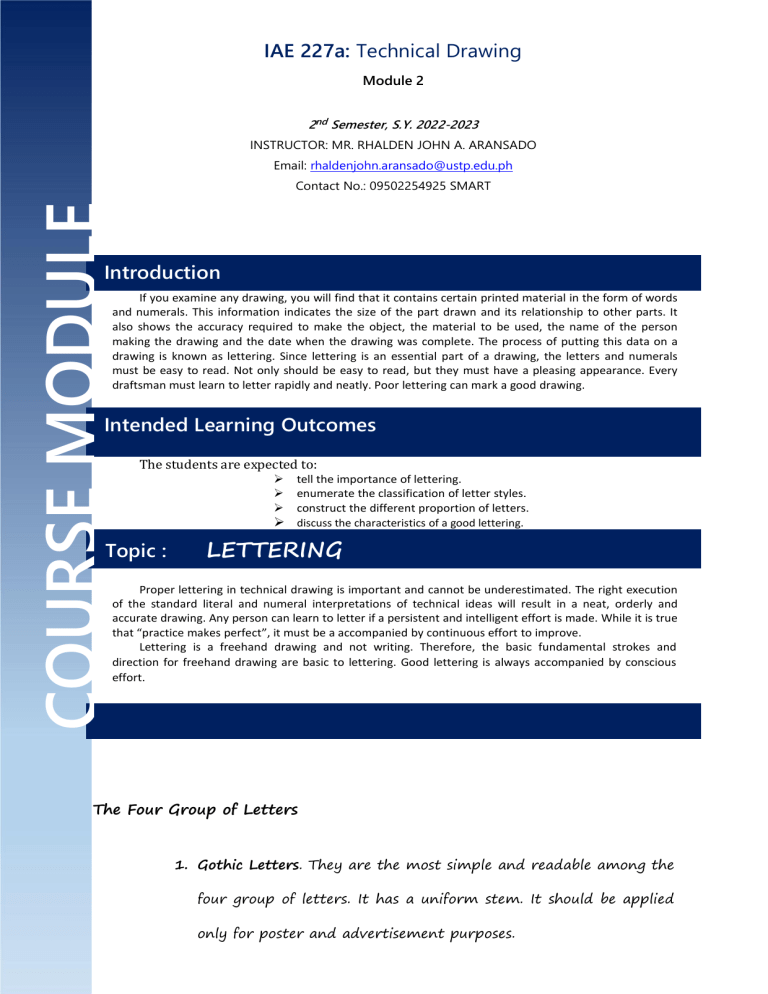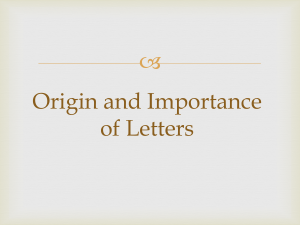
IAE 227a: Technical Drawing Module 2 2nd Semester, S.Y. 2022-2023 INSTRUCTOR: MR. RHALDEN JOHN A. ARANSADO Email: rhaldenjohn.aransado@ustp.edu.ph COURSE MODULE Contact No.: 09502254925 SMART Introduction If you examine any drawing, you will find that it contains certain printed material in the form of words and numerals. This information indicates the size of the part drawn and its relationship to other parts. It also shows the accuracy required to make the object, the material to be used, the name of the person making the drawing and the date when the drawing was complete. The process of putting this data on a drawing is known as lettering. Since lettering is an essential part of a drawing, the letters and numerals must be easy to read. Not only should be easy to read, but they must have a pleasing appearance. Every draftsman must learn to letter rapidly and neatly. Poor lettering can mark a good drawing. Intended Learning Outcomes The students are expected to: Topic : tell the importance of lettering. enumerate the classification of letter styles. construct the different proportion of letters. discuss the characteristics of a good lettering. LETTERING Proper lettering in technical drawing is important and cannot be underestimated. The right execution of the standard literal and numeral interpretations of technical ideas will result in a neat, orderly and accurate drawing. Any person can learn to letter if a persistent and intelligent effort is made. While it is true that “practice makes perfect”, it must be a accompanied by continuous effort to improve. Lettering is a freehand drawing and not writing. Therefore, the basic fundamental strokes and direction for freehand drawing are basic to lettering. Good lettering is always accompanied by conscious effort. The Four Group of Letters 1. Gothic Letters. They are the most simple and readable among the four group of letters. It has a uniform stem. It should be applied only for poster and advertisement purposes. COURSE MODULE Aa Bb Cc Dd Ee Ff Gg Hh Ii Jj Kk Ll Mm Nn Oo Pp Qq Rr Ss Tt Uu Vv Ww Xx Yy Two forms of gothic letters: a. Commercial Gothic. It is printed with heavy stem. It is used for advertisement purposes only. b. Single Stroke. It is printed with thin stem. It is used for engineering drawing purposes. 2. Roman Letters. The thickness of these letters is not uniform. they have pointed stem which is called “serif”. They must be used for books, magazine, newspapers, and text matters. Aa Bb Cc Dd Ee Ff Gg Hh Ii Jj Kk Ll Mm Nn Oo Pp Qq Rr Ss Tt Uu Vv Ww Xx Yy COURSE MODULE The Three Classics of Roman Letters: a. Old Roman Letters. They are printed by means of layout form using the flexible lettering pen. The thickness of the thin stem must be ½ from the thickness of the heavy stem. b. Modern Roman Letters. They are printed in single stroke using the speedball pen. c. Modified Roman. Similar to Modern Roman, they are printed in single stroke using the speedball pen. However, this style must be printed in the absence of serif. 3. Spanish Script. It is considered as artistic letters. It is purposely used for certificates, diplomas, citations, greetings and invitation cards. 4. Text or Old English. This style is the most artistic among the four groups of letter. Similar to Spanish script, it is also used for certificates, diplomas, citations, greetings and invitation cards. COURSE MODULE The Rule of Stability of letters This refers to the standard rules to be considered in printing the letters particularly on the following: 1. Upper Case letters. They are letters which are printed in capital form. Three guidelines are cap line, waist line, and base line. Example: cap line ABCDEFG waist line base line 2. Lower Case Letters. These are the letters which are printed in small letters printed with the use of four guidelines such as cap line, waist line, base line, and dropped line. Example: cap line abcdfgy waist line base line dropped line The General Proportion of Letters 1. Compressed or Condensed. This particular proportion should be applied only when the space is limited. The letters are printed with closer distance and its width is narrower than the normal size. Example: COMPRESSED COURSE MODULE 2. Extended. This proportion is applied when there is a more space. The width of the letter is wider than the height. Example: 3. Normal. This proportion is applied when there is normal space. The letter is printed in the normal size. Example: NORMAL The Two Proportion of Thickness 1. Boldface. This refers to the letters which are printed with heavy stem. Example: BOLDFACE 2. Lightface. This refers to the letters which are printed with thin stem. Example: COURSE MODULE Below are the suggested lettering tools and instruments and their uses: 1. used in writing different various styles Speed Ball - of letters 2. Lettering Brush - used for sign painting 3. Felt Point Pen used for sign painting 4. Letter Template - used as guide for letter transfer 5. Letter Transfer - used to direct letter transfer 6. Pencil - used for lettering and sketching 7. Technical Pen - used for Gothic letters 8. Leroy Lettering Pen -used for engineering and architectural - lettering Order of Strokes in Lettering The first letters that should be studied are I, L, T, F, E, H. These letters are the easiest to draw because the basic strokes are vertical and horizontal. You should practice making these letters according to the models. The next group P, R, B, U and J requires close study because of the introduction of the curved line aside from the three already given. The last group of letters is C, G, O, Q, D and S which are based on the circle. The M and W must be printed wider than the other letters. It is suggested therefore that its width should be greater than the other COURSE MODULE letters by 25 percent. The letter I is the thinnest letter. Making Numerals All mechanical drawings involve the use of numerals, hence, they should be studied closely. Notice that in the figures below are all 6 units and 5 units wide except 1. All figures are composed of the essential strokes found in the letters which are straight and curved. See Figure 1.1 Single stroke vertical upper case letters and numerals Figure 1.1 COURSE MODULE Single stroke vertical lower case letters Figure 1.2 Single stroke inclined upper case lower case letters and numerals Figure 1.3 Single stroke inclined lower case letters Figure 1.4

